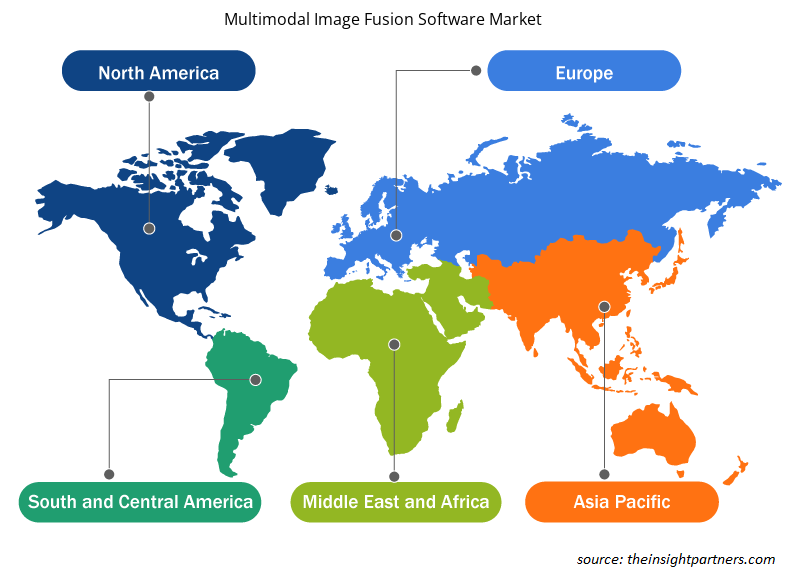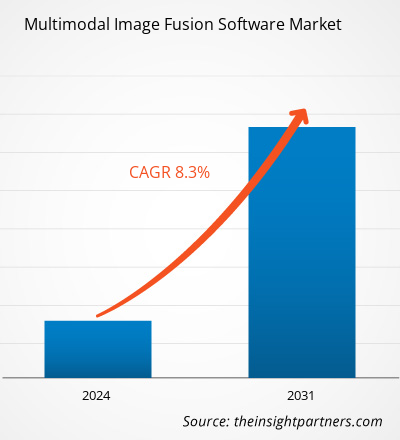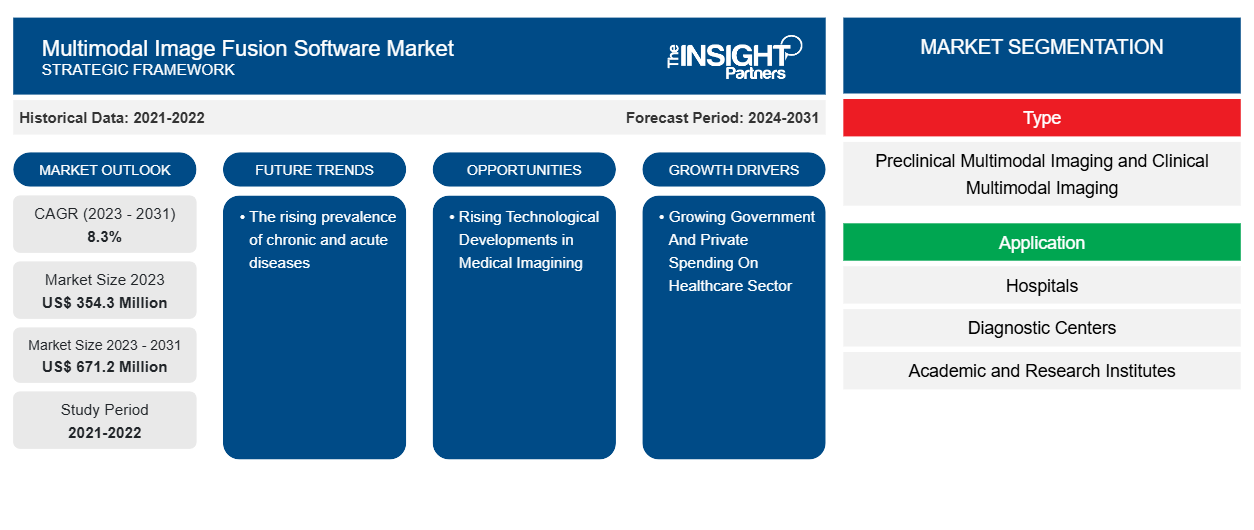Se prevé que el tamaño del mercado de software de fusión de imágenes multimodales alcance los 671,2 millones de dólares en 2031, frente a los 354,3 millones de dólares en 2023. Se espera que el mercado registre una CAGR del 8,3 % durante el período 2023-2031. Es probable que la creciente prevalencia de enfermedades crónicas y agudas siga siendo una tendencia clave en el mercado.
Análisis del mercado de software de fusión de imágenes multimodales
El software de fusión de imágenes multimodales puede producir una vista más completa y precisa de la escena al fusionar numerosas características de los datos de imágenes, lo que ayuda en la toma de decisiones y mejora el rendimiento del sistema de extremo a extremo. Además, los datos de imágenes multimodales pueden ayudar en la toma de decisiones y el rendimiento del sistema. La necesidad de tecnología de fusión de imágenes multimodales está en constante expansión debido a su amplia gama de aplicaciones. Por ejemplo, en imágenes médicas, la fusión de imágenes multimodales puede ayudar a mejorar el diagnóstico y la planificación del tratamiento al fusionar información de varias modalidades de imágenes.
Descripción general del mercado de software de fusión de imágenes multimodales
El software de fusión de imágenes multimodales intenta combinar información importante de imágenes capturadas por varios sensores en una sola imagen. Se espera que las imágenes fusionadas mantengan toda la información crítica de las fotos originales sin introducir distorsiones ni artefactos. Se prevé que el software de fusión de imágenes multimodales desempeñe un papel importante en varias aplicaciones, incluidas la conducción autónoma, los sistemas de vigilancia y la robótica. La integración de datos de muchas fuentes permite que estos sistemas funcionen en contextos complejos y dinámicos, lo que aumenta la eficiencia, la confiabilidad y la seguridad.
Personalice este informe según sus necesidades
Obtendrá personalización en cualquier informe, sin cargo, incluidas partes de este informe o análisis a nivel de país, paquete de datos de Excel, así como también grandes ofertas y descuentos para empresas emergentes y universidades.
-
Obtenga las principales tendencias clave del mercado de este informe.Esta muestra GRATUITA incluirá análisis de datos, desde tendencias del mercado hasta estimaciones y pronósticos.
Factores impulsores y oportunidades del mercado del software de fusión de imágenes multimodales
El creciente gasto público y privado en el sector de la salud favorecerá al mercado
El gasto público y privado en el sector sanitario crece continuamente en respuesta a una mejor salud pública. Por ejemplo, según los Centros de Servicios de Medicare y Medicaid de EE. UU., el gasto sanitario nacional (NHE) creció un 4,1 % hasta los 4,5 billones de dólares en 2022, o 13 493 dólares por persona. Representó el 17,3 % del producto interior bruto (PIB). El gasto de Medicare creció un 5,9 % hasta los 944 300 millones de dólares en 2022, o el 21 % del NHE total. 2021. Además, la mayor parte del gasto sanitario total en EE. UU. fue patrocinada por el gobierno federal (33 %) y los hogares (28 %). La participación de las empresas privadas en el gasto sanitario representó el 18 % del gasto sanitario total, los gobiernos estatales y locales representaron el 15 % y otros ingresos privados representaron el 7 %. La fusión de imágenes multimodales desempeña un papel fundamental en la industria médica. Está diseñada exclusivamente para imágenes médicas. Esta estrategia tiene como objetivo hacer que las imágenes médicas sean más relevantes desde el punto de vista clínico para el examen y la evaluación de las condiciones de salud, reduciendo el trabajo innecesario y mejorando la calidad. Permite un diagnóstico más preciso y agiliza el proceso de diagnóstico. En la fusión de imágenes médicas (MIF), un conjunto difuso intuicionista (IFS) ayuda a mejorar la calidad de la imagen, lo que resulta útil para el diagnóstico médico. Por lo tanto, el creciente gasto gubernamental y privado en el sector de la atención de la salud está impulsando el crecimiento del mercado.
Aumento de los avances tecnológicos en imágenes médicas
Las tecnologías de imágenes médicas están en constante evolución, lo que da lugar a nuevas aplicaciones para el diagnóstico y el tratamiento de enfermedades. Las nuevas tecnologías de imágenes médicas prometen mejorar directamente los resultados de los pacientes. Las tecnologías de imágenes médicas innovadoras prometen mejorar los resultados de los pacientes de diversas formas. Por ejemplo, los dispositivos de imágenes móviles pueden monitorear y diagnosticar a pacientes de edad avanzada sin necesidad de una sesión médica en persona . Los dispositivos médicos portátiles que incluyen componentes de imágenes hacen que sea más fácil y cómodo para los pacientes informar hechos vitales, por lo que los investigadores médicos están aprovechando la inteligencia artificial (IA), la realidad virtual (RV), las computadoras portátiles y otros avances tecnológicos para mejorar la atención médica. Las computadoras pueden imitar circunstancias del mundo real de formas que permiten a los humanos obtener nuevas ideas y puntos de vista que están más allá de su conciencia sensorial. Además, la fusión de imágenes multimodales puede ayudar a detectar y tratar trastornos complejos al fusionar información de múltiples modalidades de imágenes, como la tomografía computarizada (TC) y la resonancia magnética (IRM).
Informe de mercado de software de fusión de imágenes multimodales Análisis de segmentación
Los segmentos clave que contribuyeron a la derivación del análisis del mercado del software de fusión de imágenes multimodales son el tipo y la aplicación.
- Según el tipo, el mercado de software de fusión de imágenes multimodales se segmenta en imágenes multimodales preclínicas e imágenes multimodales clínicas.
- En términos de aplicación, el mercado está segmentado en hospitales, centros de diagnóstico e institutos académicos y de investigación.
Análisis de la cuota de mercado del software de fusión de imágenes multimodales por geografía
El alcance geográfico del informe de mercado de software de fusión de imágenes multimodales se divide principalmente en cinco regiones: América del Norte, Asia Pacífico, Europa, Oriente Medio y África, y América del Sur y Central. A medida que los hospitales y los proveedores de atención médica de América del Norte trabajan para digitalizar sus procedimientos, aumenta la demanda de empresas de desarrollo de software de atención médica calificadas. Esta publicación incluye una lista de organizaciones de desarrollo de software de atención médica notables que están listas para lograr un cambio transformador. La región de América del Norte domina la adopción de software en atención médica y otros, debido a su alta tasa de adopción de soluciones de software médico innovadoras y una gran población de pacientes, lo que garantiza su dominio durante el período de proyección. Tales casos crean oportunidades lucrativas para el crecimiento del mercado.
Perspectivas regionales del mercado de software de fusión de imágenes multimodales
Los analistas de Insight Partners explicaron en detalle las tendencias y los factores regionales que influyen en el mercado de software de fusión de imágenes multimodales durante el período de pronóstico. Esta sección también analiza los segmentos y la geografía del mercado de software de fusión de imágenes multimodales en América del Norte, Europa, Asia Pacífico, Oriente Medio y África, y América del Sur y Central.

- Obtenga datos regionales específicos para el mercado de software de fusión de imágenes multimodales
Alcance del informe de mercado del software de fusión de imágenes multimodales
| Atributo del informe | Detalles |
|---|---|
| Tamaño del mercado en 2023 | US$ 354,3 millones |
| Tamaño del mercado en 2031 | US$ 671,2 millones |
| CAGR global (2023 - 2031) | 8,3% |
| Datos históricos | 2021-2022 |
| Período de pronóstico | 2024-2031 |
| Segmentos cubiertos |
Por tipo
|
| Regiones y países cubiertos |
América del norte
|
| Líderes del mercado y perfiles de empresas clave |
|
Densidad de actores del mercado de software de fusión de imágenes multimodales: comprensión de su impacto en la dinámica empresarial
El mercado de software de fusión de imágenes multimodales está creciendo rápidamente, impulsado por la creciente demanda de los usuarios finales debido a factores como la evolución de las preferencias de los consumidores, los avances tecnológicos y una mayor conciencia de los beneficios del producto. A medida que aumenta la demanda, las empresas amplían sus ofertas, innovan para satisfacer las necesidades de los consumidores y aprovechan las tendencias emergentes, lo que impulsa aún más el crecimiento del mercado.
La densidad de actores del mercado se refiere a la distribución de las empresas o firmas que operan dentro de un mercado o industria en particular. Indica cuántos competidores (actores del mercado) están presentes en un espacio de mercado determinado en relación con su tamaño o valor total de mercado.
Las principales empresas que operan en el mercado de software de fusión de imágenes multimodales son:
- Sistemas médicos Aycan, LLC
- Laboratorio de investigación y desarrollo Brainlab AG
- Corporación Bruker
- FUJIFILM VisualSonics, Inc.
- INFINITT Norteamérica Inc.
- Mediso Ltd
Descargo de responsabilidad : Las empresas enumeradas anteriormente no están clasificadas en ningún orden particular.

- Obtenga una descripción general de los principales actores clave del mercado de software de fusión de imágenes multimodales
Noticias y desarrollos recientes del mercado de software de fusión de imágenes multimodales
El mercado de software de fusión de imágenes multimodales se evalúa mediante la recopilación de datos cualitativos y cuantitativos posteriores a la investigación primaria y secundaria, que incluye publicaciones corporativas importantes, datos de asociaciones y bases de datos. A continuación, se enumeran algunos de los avances en el mercado de software de fusión de imágenes multimodales:
- Intrasense SA ha lanzado una nueva versión de Myrian 2.9, que ya está disponible. La nueva versión del software de imágenes médicas se ha centrado más en las nuevas funciones clínicas. (Fuente: Intrasense SA, abril de 2021)
- Bruker Corporation (Nasdaq: BRKR) anunció el lanzamiento de un novedoso sistema MALDI-TOF/TOF de alto rendimiento, el neofleX Imaging Profiler para imágenes de tejidos basadas en espectrometría de masas. Permite la fácil salida de archivos OME-TIFF a través del nuevo software SCiLS Scope. El transformador sistema neofleX MALDI-TOF/TOF MSI ahora cabe cómodamente en una mesa de trabajo. (Fuente: Bruker Corporation, junio de 2024)
Informe de mercado sobre software de fusión de imágenes multimodales: cobertura y resultados
El informe “Tamaño y pronóstico del mercado del software de fusión de imágenes multimodales (2021-2031)” proporciona un análisis detallado del mercado que cubre las siguientes áreas:
- Tamaño del mercado de software de fusión de imágenes multimodales y pronóstico a nivel global, regional y nacional para todos los segmentos clave del mercado cubiertos bajo el alcance
- Tendencias del mercado de software de fusión de imágenes multimodales, así como dinámicas del mercado, como impulsores, restricciones y oportunidades clave
- Análisis detallado de las cinco fuerzas de Porter y PEST y FODA
- Análisis del mercado de software de fusión de imágenes multimodales que abarca las tendencias clave del mercado, el marco global y regional, los principales actores, las regulaciones y los desarrollos recientes del mercado
- Análisis del panorama de la industria y de la competencia que abarca la concentración del mercado, el análisis de mapas de calor, los actores destacados y los desarrollos recientes para el mercado de software de fusión de imágenes multimodales
- Perfiles detallados de empresas.
- Análisis histórico (2 años), año base, pronóstico (7 años) con CAGR
- Análisis PEST y FODA
- Tamaño del mercado, valor/volumen: global, regional y nacional
- Industria y panorama competitivo
- Conjunto de datos de Excel
Informes recientes
Informes relacionados
Testimonios
Razón para comprar
- Toma de decisiones informada
- Comprensión de la dinámica del mercado
- Análisis competitivo
- Información sobre clientes
- Pronósticos del mercado
- Mitigación de riesgos
- Planificación estratégica
- Justificación de la inversión
- Identificación de mercados emergentes
- Mejora de las estrategias de marketing
- Impulso de la eficiencia operativa
- Alineación con las tendencias regulatorias























 Obtenga una muestra gratuita para - Mercado de software de fusión de imágenes multimodales
Obtenga una muestra gratuita para - Mercado de software de fusión de imágenes multimodales